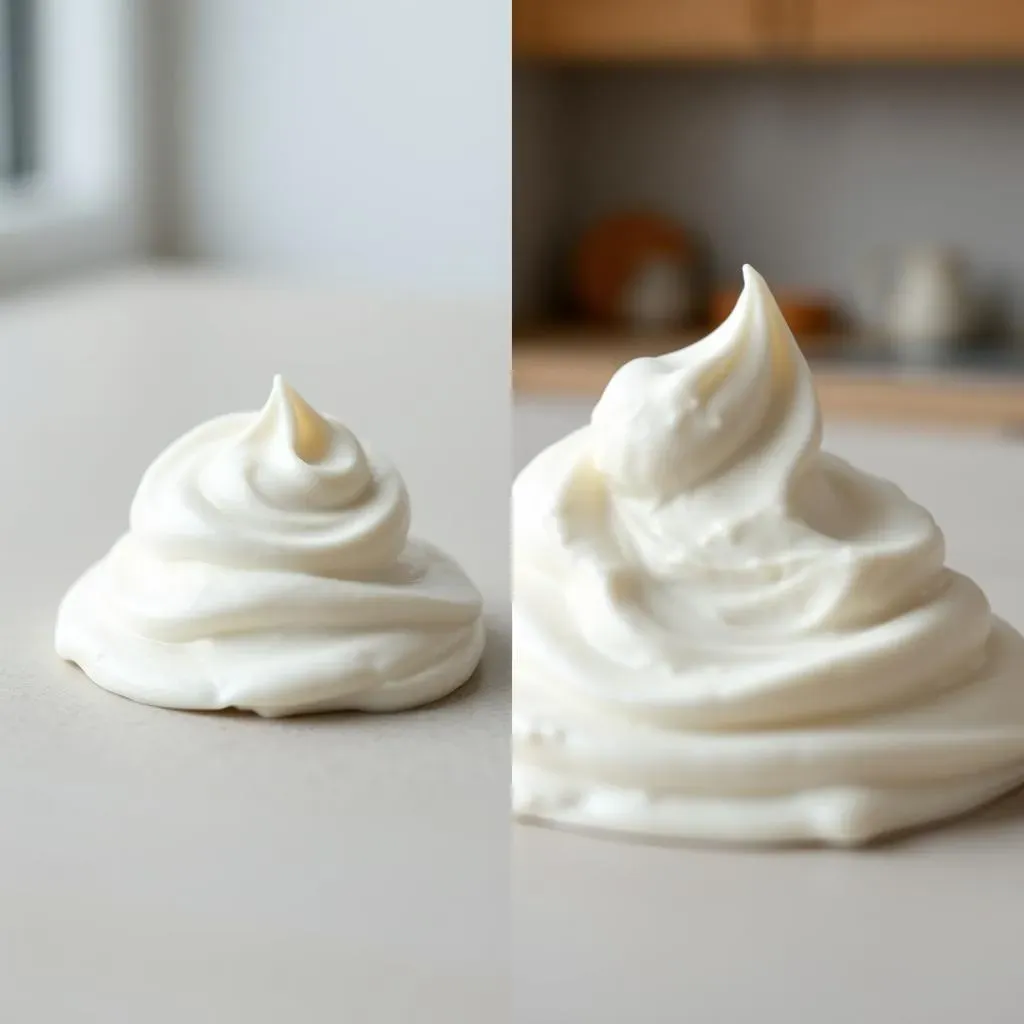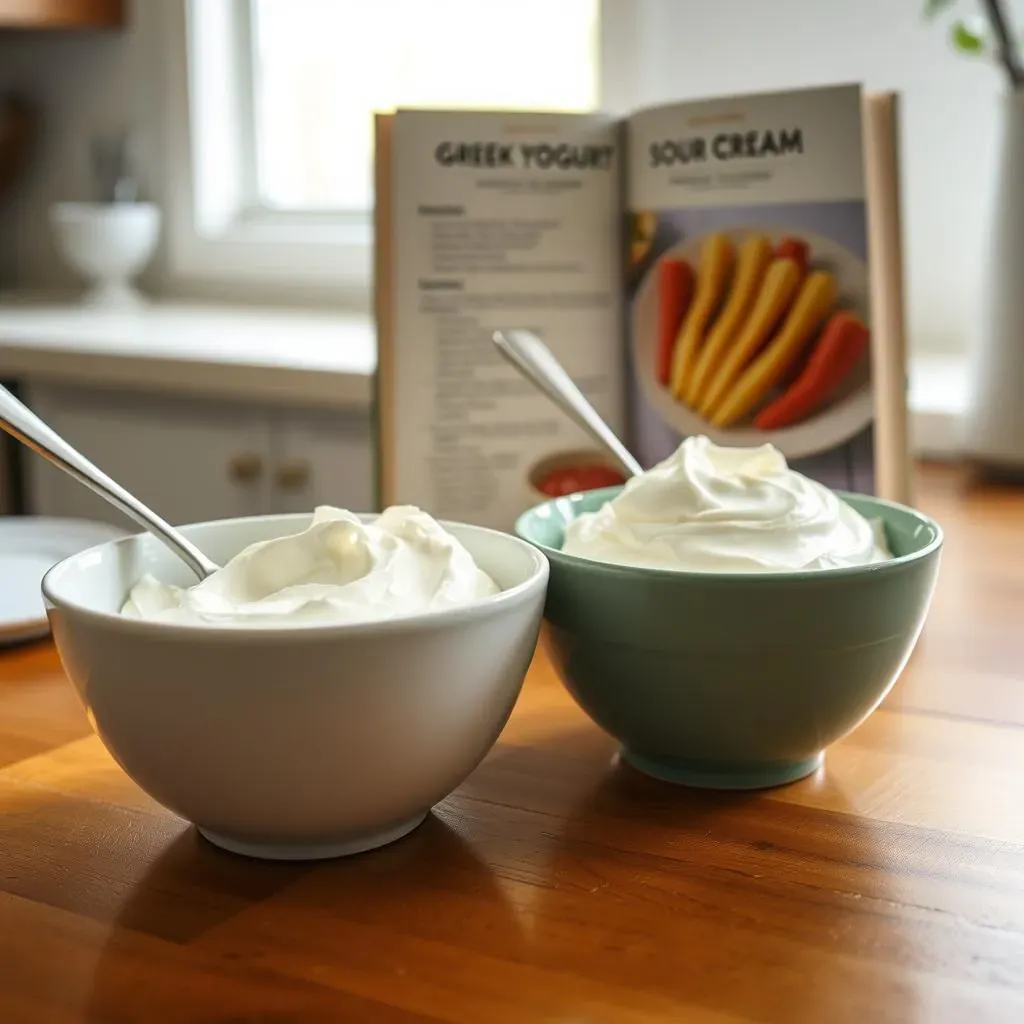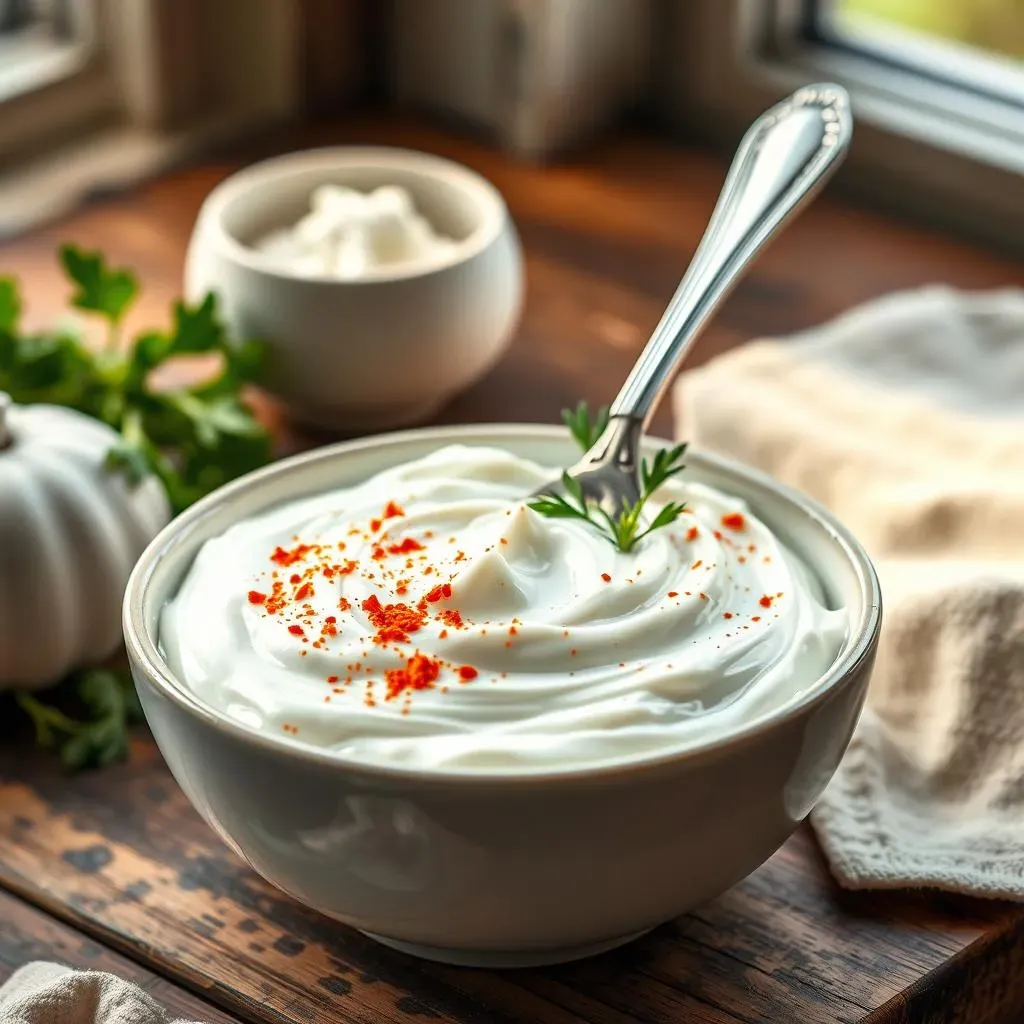Table of Contents
Ever stared into your fridge, needing sour cream, but only finding a tub of Greek yogurt? You're not alone. Many of us face this kitchen conundrum, wondering if we can use one for the other. The good news? You absolutely can! This article is your go-to guide for how to substitute greek yogurt for sour cream, whether you're whipping up a dip, baking a cake, or topping your tacos. We'll explore why this swap works so well, the best ways to make it happen, and even how to tweak your yogurt to mimic that classic sour cream tang. Get ready to unlock a healthier, equally delicious alternative that might just become your new favorite kitchen hack. We will cover everything from choosing the right type of yogurt to adjusting your recipes for the perfect outcome. Let's get started!
Why Substitute Greek Yogurt for Sour Cream?

Why Substitute Greek Yogurt for Sour Cream?
Healthier Choice
Let’s be real, sour cream is delicious, but it's not exactly a health food. It's loaded with fat and doesn't offer much in the way of nutritional benefits. Greek yogurt, on the other hand, is a total powerhouse. It’s packed with protein, which keeps you feeling full and helps build muscle. It also has fewer calories and less fat than sour cream, making it a great option if you're trying to eat a bit healthier. I mean, who doesn't want to indulge without the guilt? It's like having your cake and eating it too, but instead of cake, it’s a dollop of creamy goodness.
Consider this, swapping sour cream for Greek yogurt is a simple way to boost your protein intake without sacrificing flavor. For instance, when I make my famous seven-layer dip, I use Greek yogurt instead of sour cream. My friends and family can’t even tell the difference, and I feel good knowing I'm serving them something a little better for them. Plus, it's a sneaky way to get some extra calcium into your diet, which is great for strong bones. It's a win-win situation, really.
Taste and Texture
Okay, so health benefits are great, but what about the taste? I get it, sour cream has that distinct tangy flavor and rich texture. Here’s the kicker – Greek yogurt can totally mimic that. It has a natural tanginess that's similar to sour cream, and if you go for the full-fat variety, you'll get a really similar creamy texture. It’s not exactly the same, but it's so close that most people won't notice the difference, especially when it's mixed into a recipe. Think about it: that creamy, slightly sour note you love in dips and sauces? Greek yogurt has got you covered.
I remember the first time I tried using Greek yogurt in my mashed potatoes. I was skeptical, but the result was amazing! They were just as creamy and delicious as when I use sour cream. The slight tang of the yogurt actually added a nice depth of flavor. It also works wonders in things like creamy pasta sauces or even as a topping for baked potatoes. The trick is to choose the right kind of Greek yogurt – full-fat is key if you want that luxurious feel. So, you can have that creamy, tangy goodness without any of the extra baggage.
Nutrient | Sour Cream (1 tbsp) | Greek Yogurt (1 tbsp, Whole Milk) |
|---|---|---|
Calories | 23 | 19 |
Fat | 2.4g | 1g |
Protein | 0.2g | 2g |
Calcium | 6mg | 22mg |
How to Substitute Greek Yogurt for Sour Cream

How to Substitute Greek Yogurt for Sour Cream
The Basics: A Simple Swap
Alright, so you're ready to ditch the sour cream and embrace the Greek yogurt life. Great choice! The easiest way to do this is a straight-up, one-to-one swap. That means, if your recipe calls for one cup of sour cream, you use one cup of Greek yogurt. It's that simple. Now, there are a few things to keep in mind to get the best results, but for most recipes, this basic substitution works like a charm. I've done this in countless recipes, from dips to sauces, and it's never failed me. It's like a magic trick for a healthier meal, but without the need for a wand.
However, while a 1:1 swap is generally fine, the type of Greek yogurt you use matters. Full-fat Greek yogurt will give you the closest match in terms of richness and texture. If you're using low-fat or non-fat yogurt, you might find that the end result is a bit thinner or less creamy. It's not a deal-breaker, but it's something to be aware of. Think of it like choosing the right tool for the job; using the right yogurt will make your dish taste that much better. The next time you're at the grocery store, take a look at the labels and see the difference in fat content – it's a game-changer.
Adjusting for Consistency
Sometimes, Greek yogurt can be a bit thicker than sour cream, and other times, it might be a tad thinner, especially if it’s not a full-fat variety. If you find your yogurt is too thick, you can thin it out by adding a tablespoon or two of milk or water until you reach the desired consistency. This is particularly handy when you’re making a dip or a sauce where you want a smoother texture. On the flip side, if your yogurt is too thin, you can strain it. Simply line a sieve with cheesecloth and let the yogurt sit in the fridge for a few hours. The excess liquid will drain out, leaving you with a thicker, more sour cream-like texture. It’s like giving your yogurt a little spa day, and it comes out feeling refreshed and ready to go.
I once tried to make a creamy pasta sauce with low-fat Greek yogurt, and it was just too runny. I quickly learned that straining the yogurt is the key. The difference was night and day. The sauce went from watery to wonderfully thick and creamy. It’s all about being flexible and understanding how to adjust your ingredients. Another trick I use is to add a little bit of cornstarch to the yogurt while it’s heating up, this helps to create a thicker consistency as well. You're not stuck with what you have; you can always make adjustments to get it just right.
Issue | Solution |
|---|---|
Yogurt is too thick | Add milk or water, 1 tbsp at a time |
Yogurt is too thin | Strain through cheesecloth in the fridge |
Need a thicker sauce | Add cornstarch while heating up |
Greek Yogurt Substitute for Sour Cream: Baking and Cooking Tips

Greek Yogurt Substitute for Sour Cream: Baking and Cooking Tips
Baking with Greek Yogurt
Okay, let's talk baking. This is where things get a little more interesting, but don't worry, it's still totally doable. When you substitute greek yogurt for sour cream in baking, you're not just making a healthier swap, you're also adding a bit of moisture to your baked goods. This can result in cakes, muffins, and breads that are incredibly tender and moist. I've used Greek yogurt in everything from chocolate cake to banana bread, and it always turns out fantastic. The key is to remember that Greek yogurt is a bit more acidic than sour cream, so it can affect the rise and texture of your baked goods.
To counteract this, you might want to add a pinch of baking soda to your recipe. This helps to neutralize the acidity and ensure your baked goods rise properly. Also, keep in mind that full-fat Greek yogurt will give you the best results in baking, as it provides the richness and moisture that you'd typically get from sour cream. Low-fat or non-fat yogurt can work, but you might need to adjust the liquid content in your recipe to prevent it from becoming too dry. It’s a bit of a balancing act, but once you get the hang of it, you’ll be amazed at how well Greek yogurt works. I remember the first time I used Greek yogurt in my red velvet cupcakes – they were so moist and delicious, everyone raved about them. It's like discovering a secret ingredient that makes everything better.
Cooking with Greek Yogurt
Now, let’s move on to cooking. Greek yogurt is a fantastic addition to many savory dishes, adding both creaminess and tang. Think of it as a secret weapon for sauces, soups, and stews. When you use it in cooking, it's best to add it towards the end of the cooking process, or off the heat entirely. If you add it too early or at too high of a temperature, it can curdle or separate. Nobody wants a grainy sauce, right? I always stir in a dollop of Greek yogurt at the end of my creamy tomato soup to give it that extra velvety texture. It's the perfect finishing touch.
Another great way to use Greek yogurt is in marinades. The acidity helps to tenderize meat, while the creamy texture helps the marinade cling to the surface. I often use it in my chicken marinades, and the results are always juicy and flavorful. You can also use it as a base for creamy salad dressings or as a topping for baked potatoes. The possibilities are endless! It's like having a versatile ingredient that can transform your dishes from ordinary to extraordinary. Just remember to add it at the right time and temperature, and you’ll be cooking like a pro in no time.
Baking Tip | How to Use |
|---|---|
Add Baking Soda | Neutralizes acidity for better rise |
Use Full-Fat Yogurt | Provides richness and moisture |
Adjust Liquid | Prevents dry baked goods |
Cooking Tip | How to Use |
|---|---|
Add off heat | Prevents curdling in sauces |
Use in marinades | Tenderizes and adds flavor to meat |
Base for dressings | Creamy texture |
Making Greek Yogurt Taste Like Sour Cream

Making Greek Yogurt Taste Like Sour Cream
The Acidity Adjustment
Alright, let's get down to the nitty-gritty of flavor. Greek yogurt is tangy, sure, but it's not quite as sharp as sour cream. The secret to getting that signature sour cream zing? Acidity. You can easily boost the tartness by adding a little bit of lemon juice or vinegar. I usually start with about a teaspoon of lemon juice per cup of Greek yogurt, then taste and add more as needed. It's like giving your yogurt a little wake-up call. The lemon juice not only adds acidity but also a fresh, bright flavor that complements the creaminess of the yogurt. I’ve even used lime juice when I want a slightly different twist.
Another option, if you don't have lemon or lime on hand, is to use white vinegar or apple cider vinegar. Just be careful with vinegar, as it can be quite strong. Start with a smaller amount, like half a teaspoon per cup of yogurt, and adjust from there. The goal is to replicate that familiar tang without overpowering the yogurt. It's a bit of an experiment, but once you find the right balance, you’ll be amazed at how close you can get to that authentic sour cream taste. It’s like being a flavor scientist in your own kitchen, and the results are always delicious.
Enhancing the Creaminess
Now, let's talk texture. While full-fat Greek yogurt is pretty creamy, it might not have the exact richness of sour cream. To get that extra luxurious feel, you can add a little bit of heavy cream or even a touch of olive oil. I usually add a tablespoon of heavy cream per cup of yogurt, which makes it extra smooth and decadent. It's like giving your yogurt a little spa treatment, turning it into a velvety cloud of deliciousness. The heavy cream adds that extra layer of richness that makes it feel closer to sour cream.
If you’re looking for a lighter option, you can use a bit of milk instead of heavy cream. It won’t be quite as rich, but it will still help to thin out the yogurt and make it smoother. Another trick I sometimes use is to add a tiny bit of mayonnaise. It might sound weird, but it adds a subtle richness and tang that really works. Just use a tiny amount, like half a teaspoon per cup of yogurt. It’s all about finding the right combination of ingredients to create that perfect balance of flavor and texture. It’s like being a culinary artist, and your yogurt is the blank canvas.
Ingredient | Amount per 1 cup of Greek Yogurt | Purpose |
|---|---|---|
Lemon Juice | 1 tsp (adjust to taste) | Adds tanginess |
Heavy Cream | 1 tbsp | Enhances richness |
Mayonnaise | 1/2 tsp (optional) | Adds subtle tang and richness |
Flavor Tweaks
Beyond acidity and creaminess, you can also play around with other flavors to make your Greek yogurt taste even more like sour cream. A pinch of salt can enhance the overall flavor and bring out the tanginess. I also like to add a touch of onion powder or garlic powder for a bit of savory depth. These additions might seem small, but they can make a big difference in the final taste. It’s like adding the perfect seasoning to a dish, making all the flavors come together in harmony.
Another trick I've tried is adding a tiny bit of mustard powder. It adds a subtle tang and warmth that can mimic the sharpness of sour cream. You can also experiment with adding a few drops of Worcestershire sauce for a more complex flavor. It’s all about experimenting and finding what works best for you. The key is to taste as you go and adjust the flavors to your liking. It’s like being a chef in your own kitchen, and your taste buds are the ultimate guide. Once you master these little tweaks, you’ll be able to make your Greek yogurt taste just like sour cream, if not better!